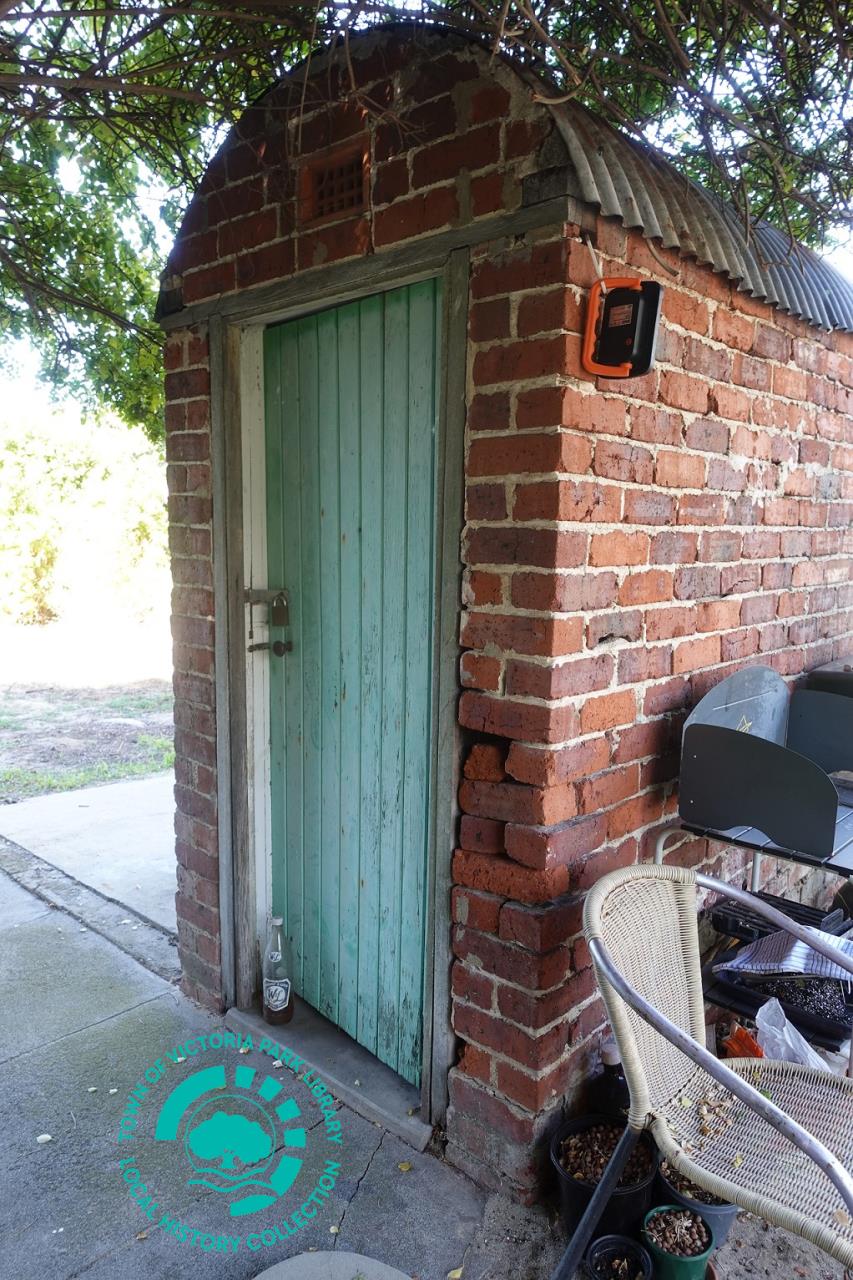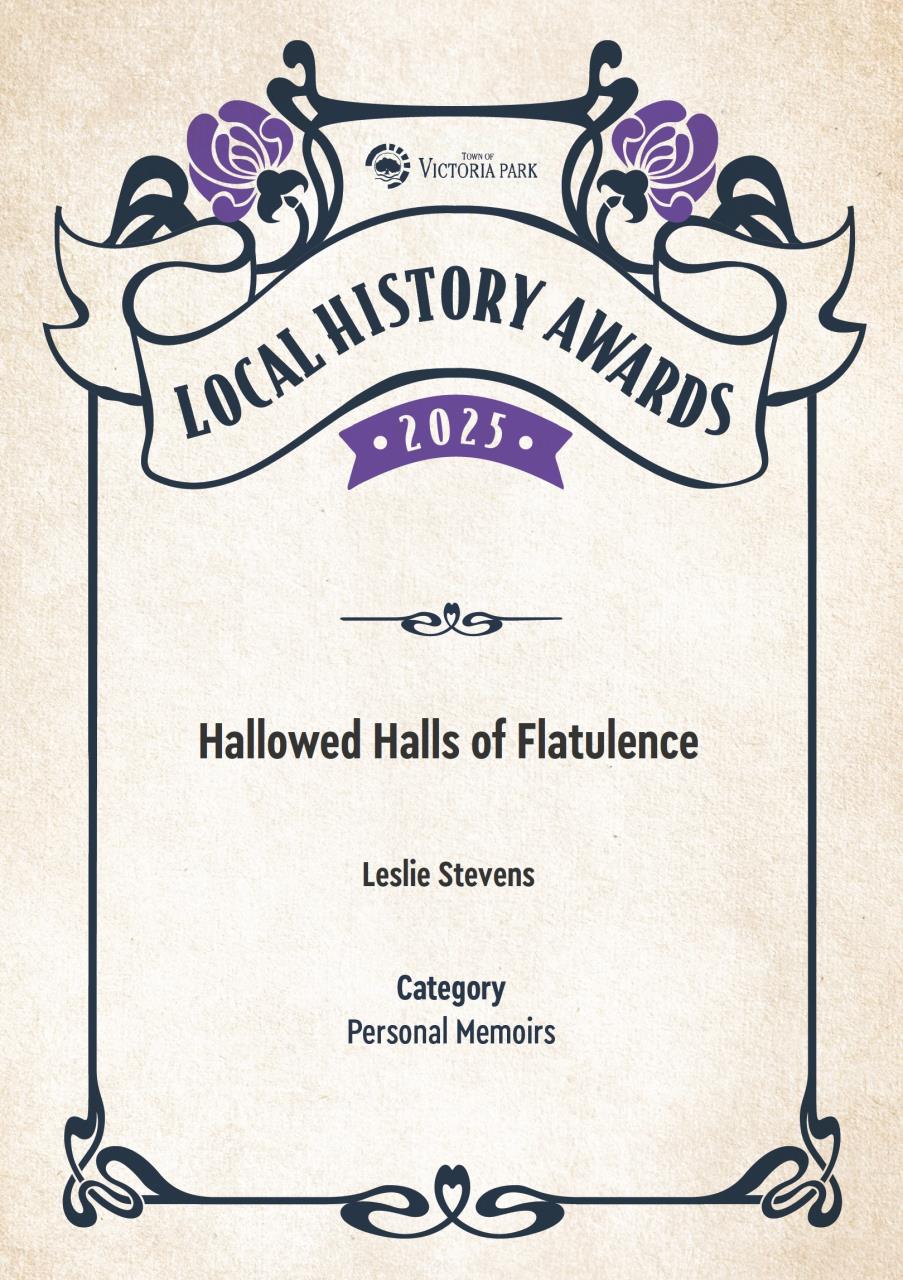Published on Tuesday, 7 October 2025 at 8:00:00 AM
It’s #TimeWarpTuesday, and today we feature the second and final part of Leslie Stevens unique look at a part of our social history from his entry into the 2025 Local History Awards…
Personal Memoirs
‘Hallowed Halls of Flatulence’
By Leslie Stevens
-Part Two (Final)-
For a long time, those laneways remained separating the rows of houses, at least in the East Victoria Park area, long after sewerage was provided. I have distinct memories, of such a laneway near our house. It ran from Gloucester St. to Washington St, between the houses, that faced Canning Highway and Armagh St. Though, I cannot ever recall, seeing a “Night Cart” in that laneway. I think that, that particular laneway, must have been a remnant of those pre sewerage days. But from memory, it was definitely used, by the residents for the access, that I mentioned in the previous paragraph.
The construction of these backyard edifices was variable. Some were built in timber, others, with bricks and mortar. But even those varied, in the type of brick used. Most were of inelegant design, but then, the purpose for which they were built, was not one that required style. Their basic requirements were privacy. A seat with a suitable functional hole, to fit most bottoms, and a means to discretely remove the waste material so accumulated. Some used the standard kiln fired clay brick, while other people made their own Cement bricks. Almost all sported galvanised Iron roofs. Although, having said that, some of the more elaborate ones, may have had tiled roofs.
But whatever their construction, their locations, were largely the same. On or near the back fence line.
 PH00339-03 Outside toilet building, East Victoria Park, 2025
PH00339-03 Outside toilet building, East Victoria Park, 2025
Local History Collection, Town of Victoria Park Library Service
But regardless of their construction, they all served their useful purpose admirably. Despite the reputation of Red Backs on the toilet seats! Dunnie’s were places of solitude and peace, where one could sit and think. Or in normal circumstances, where one could do what, in words, sounds crudely familiar! The solitude of the Dunny was only broken by the buzz of Blowflies, or vehicles passing along the lane, at their rear.
When these “throne rooms” fell into disuse, with the advent of the extending sewerage networks, there was a general downturn in their welbeing. Through lack of use, and care, the wooden ones suffered from the weather, dry rot, and or termites, or all three, and simply collapsed. The more robust brick toilets, still stood for quite some time. Often being used as a small garden shed, until the householders decided they had become an eyesore, or an embarrassment, that needed to be removed.
But there are still people out there, who consider this relic of our past, to be of enough significant historical interest, to actually build their own replicas. My niece Sandra Irwin of Wattle Camp, in Queensland is one such person. Having a large amount of garden to play with, she has built a full size one, to adorn it. See picture following!
Though I also know, that in the early 1950’s it became the accepted thing, where no sewerage was available, for all new housing, to have toilets, that were connected to a Septic Tank.
Toilets, were then, incorporated into such systems, whether they were located internally, externally or not. In those early 1950’s, my father built a house in Belmont, which used the septic tanks idea. The toilet there, was located just off the back veranda.
Again, as a variant to the septic tanks, on larger properties, and rural situations, where space allowed, some homes used a system called a Leach Drain.
This was a variant of the Septic Tank, and was also a below ground system. Sometimes in in two parts, that could be used alternately. In 1997 I had a house built on a five acre property, at Northcliffe, in the states lower South west. It utilized this Leach Drain system. It had two parts, controlled with a flip flop type switching arrangement, for alternate use. These humble establishments at the bottom of the garden were often referred to by many names in Australian slang. Depending on which state you came from. There were the rather more socially accepted “ Little House”, “Loo” and “W.C”. But there were also more vulgar terms, like “The “Bog”, and “Sh*t” house, Etc.
There were of course also the humorous connotations like “Thunder Box “. But the most accepted term used, was “Dunny”. “Thunder Box” of course, generally related to the sounds of Flatulence, which could emanate from it, when one was in use.
With the term “Dunny“ however, research has revealed, that it is most likely derived, from two Scottish words, of the early 1800’s, that were joined together to make the term, “Dunnekin”. The first part of that word, denoted Dung, and the second part “Kin” or “Ken,” meant house or outbuilding. So hence we have Dunnekin, or “Dunghouse”. It is highly likely that early Scottish migrants, brought the term to Australia with them. But, with us Aussies having a penchant to shorten things, it simply became a “Dunny”. At least that is the most plausible explanation that I can offer.
You would be extremely unlikely, to find one of these “Hallowed Halls of Flatulence”, anywhere in the country’s major city or town areas today. But should you happen to visit a town, in the remote back blocks, the chances are, you may just get the chance to see one. Standing forgotten, in the back yard, of one of the towns, veteran residences.
Having said that, in the early 2000’s I became aware that, that the Department of Conservation and Land Management, otherwise known then, as C.A.L.M, and now as the Department of Parks and Wildlife, provided what are often referred to, as “Long Drop” toilets, at various rural picnic and BBQ sites. These singular free standing, little buildings of convenience, were in actual fact, not far removed from the design of the old backyard “Dunny”. At the time I lived in Northcliffe, and organised outings, for a group of seniors. We visited many of these sites, scattered throughout the surrounding districts, for picnics and BBQ’s.
So, I was aware of them, and where they were. One such toilet, is near where the Donnelly River boat cruise, sails from. There were others, but I am not going to list them here. It will be just suffice to say, that most were very similar to the backyard “Dunny”.
There is however, a great difference between the two. The back yard “Dunny”, with its Redback Spiders, is constrained within, its fixed fence lines, and a static garden scene, dependant on its can being regularly changed. Whereas the “Long Drop”, is out among the birds, in the everchanging panorama, of a rural scene, and needs no regular care. It is more likely to have a resident Huntsman Spider, than a Red Back!
Despite all that, there was however, the answer to one question, with respect to the backyard “Dunny”, which did always leave me wondering! How many bare bums, poking through the toilet seat, did those blokes see, during their day, changing those “Dunny” cans? Because, they would have had absolutely no idea, if someone was using the “Dunny” at that time, when they lifted the lid to change the can!
Being an inquisitive type of person, I wondered, what the situation was, in other countries. So, as I have a cousin in England, and a friend in the U.S.A. I asked the question, of what happened in their countries. It seems that “outhouse”, in one form or another, were also fairly common, in the early years, before the proliferation of sewerage, in those countries too!
So by the process of assumption, I would say that it is an educated guess, that most of the civilised countries of Europe, and the America’s, also had “outhouses”, in one form or another. So like it or lump it, “The Dunny”, or its counterpart, came into being, a long time ago. So in my mind, they must be given their rightful place in our history, which is why I wrote this story!!!.
To end this little expose, into my memories of the past, a comment that I must also make. Is that very few of those laneways, once used by the “Nightcarters”, in the course of their employment, still exist today, in the local residential environment. Some, or portions thereof, have been, I believe, incorporated into the holdings of their adjacent land owners. And the Redback and Daddy Long Leg Spiders must find other homes. While the Blowflies can simply buzz off!
There is one thing however, that I am sure, that this story has done. That is, to bring a smile to the faces, of those generations born before the late 1950’s. It has probably brought back to them, memories of that that little establishment, at the far end, of the garden path, that they had almost forgotten existed.
R.I.P (Rest In Past) Dunnies
-The End-
We hope you enjoyed this foray into the land of the euphemism and the backyard toilet. Join us next week as we share the first of our poetical entries into the Awards.
Don’t forget we are always happy to accept donations of photographs, memorabilia and stories about the suburbs within our Town. Don’t hesitate to get in touch with us via telephone: 08 9373 5500, email: vicparklibrary@vicpark.wa.gov.au or in person at 27 Sussex Street, East Victoria Park.
#LoveVicPark

Exhibition cover page for Leslie’s entry in the Personal Memoirs category of the 2025 Local History Awards
Local History Collection, Town of Victoria Park Library Service
Back to All News